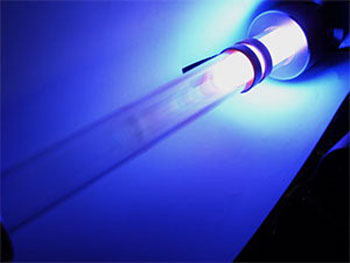| Jul 30, 2013 |
Engineers discover novel technology for producing nanocrystal electronic ink
|
|
(Nanowerk News) Electronic touch pads that cost just a few dollars and solar cells that cost the same as roof shingles are one step closer to reality today.
|
|
Researchers in the University of Minnesota’s College of Science and Engineering and the National Renewable Energy Laboratory in Golden, Colo., have overcome technical hurdles in the quest for inexpensive, durable electronics and solar cells made with non-toxic chemicals. The research was published in the most recent issue of Nature Communications ("Hypervalent surface interactions for colloidal stability and doping of silicon nanocrystals"), an international online research journal.
|
|
"Imagine a world where every child in a developing country could learn reading and math from a touch pad that costs less than $10 or home solar cells that finally cost less than fossil fuels," said Uwe Kortshagen, a University of Minnesota mechanical engineering professor and one of the co-authors of the paper.
|
 |
| Light is emitted from excited argon gas atoms flowing through the glass tube of a plasma reactor. The plasma is a reactive environment used to produce silicon nanocrystals that can be applied to inexpensive, next-generation electronics.
|
|
The research team discovered a novel technology to produce a specialized type of ink from non-toxic nanometer-sized crystals of silicon, often called "electronic ink." This "electronic ink" could produce inexpensive electronic devices with techniques that essentially print it onto inexpensive sheets of plastic.
|
|
"This process for producing electronics is almost like screen printing a number on a softball jersey," said Lance Wheeler, a University of Minnesota mechanical engineering Ph.D. student and lead author of the research.
|
|
But it’s not quite that easy. Wheeler, Kortshagen and the rest of the research team developed a method to solve fundamental problems of silicon electronic inks.
|
|
First, there is the ubiquitous need of organic "soap-like" molecules, called ligands, that are needed to produce inks with a good shelf life, but these molecules cause detrimental residues in the films after printing. This leads to films with electrical properties too poor for electronic devices. Second, nanoparticles are often deliberately implanted with impurities, a process called "doping," to enhance their electrical properties.
|
|
In this new paper, researchers explain a new method to use an ionized gas, called nonthermal plasma, to not only produce silicon nanocrystals, but also to cover their surfaces with a layer of chlorine atoms. This surface layer of chlorine induces an interaction with many widely used solvents that allows production of stable silicon inks with excellent shelf life without the need for organic ligand molecules. In addition, the researchers discovered that these solvents lead to doping of films printed from their silicon inks, which gave them an electrical conductivity 1,000 times larger than un-doped silicon nanoparticle films. The researchers have a provisional patent on their findings.
|
|
"What this research means is that we are one step closer to producing more pure and more stable electronic ink with non-toxic chemicals," Kortshagen said. "The bigger goal here is to find a way that this research can benefit everyone and make a real difference."
|

